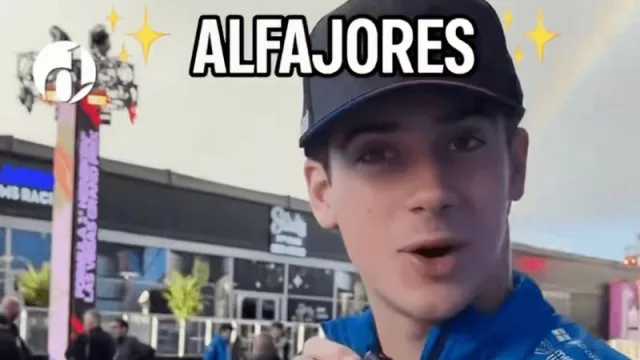In the Las Vegas paddock, under neon lights that have witnessed fortunes won and lost, a moment was forged that marketing experts will study for years. Franco Colapinto, the Argentine driver who has revolutionized Formula One on and off the track, shared Havanna alfajores with his Williams Racing team.
-
What might seem like a casual nostalgic gesture is, in reality, the materialization of a disruptive trend redefining the influencer ecosystem: the triumphant return of authentic celebrities as primary creators of valuable content.
The Neurological Anatomy of a Genuinely Viral Moment
-
When Colapinto pulls a Havanna box from the garage—the world’s most technologically advanced in motorsport—he triggers multiple neurological responses simultaneously. According to Dr. Paul Zak, neuroeconomist at Claremont and author of Trust Factor, these moments of cultural authenticity spur oxytocin release—the “molecule of trust”—in global audiences, delivering engagement tenfold that of traditional advertising content.
-
This is Colapinto’s third instance executing this strategy since arriving in the top tier. It’s not coincidence: it’s strategic spontaneity, the art of planned spontaneity that governs about 0.5% of the personalities who grasp the digital zeitgeist.
The Decline of the Intermediate Influencer and the Celebrity-Centric Renaissance
-
Over the past decade, the dominant paradigm held that influencers—professional lifestyle curators—were the optimal vehicle for brand storytelling. Yet Edelman Trust Barometer 2024 reveals a tectonic shift: 67% of Gen Z consumers trust celebrities with tangible achievements more than influencers whose credential is follower count.
-
“We are witnessing the return of the Hollywood classic model adapted to the digital era,” says Dr. Karen Nelson-Field, Professor of Media Innovation at the University of Adelaide and author of Viral Marketing: The Science of Sharing. “The critical difference is that celebrities now control the narrative directly, without traditional intermediaries.”
-
Colapinto embodies this archetype: an elite athlete with verifiable credentials (the first Argentine in F1 since 2001), a millennial-native generation that instinctively understands platform language, and bearer of specific cultural capital (Argentinidad as brand equity).
Havanna: More Than Alfajores, A National Identity Architecture
-
Founded in 1947 in Mar del Plata, Havanna has evolved from regional confectionery to national gastronomic ambassador. With presence in more than 40 countries and annual revenues above $200 million, the brand epitomizes glocalization—a term coined by sociologist Roland Robertson—where hyperlocal resonates globally.
-
The alfajor functions as a cultural Trojan horse. Martin Lindstrom, author of Buyology, documented how emotionally territorial products trigger brain responses akin to religious symbols, activating identity and belonging regions.
-
When Colapinto distributes Havanna in Las Vegas—the epicenter of American entertainment capitalism—he executes a reverse cultural colonization operation. He’s not selling a product; he’s exporting experience, shared memory, and South American sophistication to a context that has historically dictated global trends.
Product Placement 3.0: The Science Behind “Accidental” Content
-
The strategic genius lies in the appearance of naturalness. Unlike traditional cinematic product placement—extensively studied by scholars like James Karrh in Brand Placement: A Review—this format avoids psychological reactance (resistance to overt persuasion).
-
The Havanna appearances in Colapinto’s ecosystem follow a pattern of strategic serialization. This frequency respects the mere-exposure effect documented by Robert Zajonc: repeated exposure without saturation yields automatic preference.
Las Vegas as a Metaphorical Stage: Decoding the Context
-
Choosing Las Vegas for the third manifestation is not arbitrary. The city embodies calculated risk-taking, a theme that resonates with Colapinto’s narrative: a young driver from a non-traditional nation in F1 who bets against long odds.
-
Edward Soja, urban geographer and author of Thirdspace, described Las Vegas as a heterotopia—an space where contradictory realities coexist. An Argentine driver sharing alfajores in the temple of American excess perfectly crystallizes this juxtaposition.
-
The Amplification Model: Celebrity as Epicenter, Influencers as Seismic Waves
-
The emerging viral framework positions authentic celebrities generating primary content, while influencers act as signal amplifiers. It’s hub-and-spoke content distribution applied to marketing.
-
Traackr data show content created by “earned authority” figures receives 340% more organic engagement than influencer-driven content, though it requires influencer ecosystems for diverse reach.
Miami as Observatory: Why This Phenomenon Matters for the Latin American Hub
-
Miami has consolidated as the epicenter of convergence between Latin American capital, Hispanic U.S. audiences, and global brands seeking access to emerging markets. The Colapinto‑Havanna phenomenon offers a replicable blueprint for local players with regional ambitions.
-
According to the Miami-Dade Beacon Council, the marketing and advertising sector in the region grew 47% since 2020, driven precisely by demand for strategies that fuse cultural authenticity with global digital reach.
The Future Colapinto Is Building: Predictions for 2025–2030
Strategists project five trends derived from this model:
-
Agency disintermediation: celebrities managing brand partnerships directly
-
Heritage-brand valorization: brands with history outperforming disruptive startups in authentic storytelling
-
Territorial geo-branding: regional products as vehicles of soft power
-
Performance-driven celebrity deals: compensation tied to engagement metrics, not just reach
-
Vertical content integration: athletes/artists building their own production studios
When Alfajores Transcend Gastronomy
-
Ultimately, what we’re witnessing is not just smart marketing. It’s the democratization of global storytelling, where a 21-year-old driver from a country with little recent F1 tradition can spark planetary conversations through a handmade product from his homeland.
-
Marshall McLuhan’s insight from Understanding Media—the medium is the message—still holds. But in 2025, we’d add: the authentic messenger is the unbeatable competitive differentiator.
-
Colapinto doesn’t sell alfajores. He sells the possibility that any brand, any story, any identity—communicated with strategic integrity—can conquer markets once deemed unreachable.
-
The question is no longer whether your brand needs influencers. It’s whether you have an authentic celebrity with a real story
Read Smart, Be Smarter!
Infonegocios Miami: a publication written by the Anglolatina business community.
Follow for more analysis: @InfonegociosMiami
https://infonegocios.miami/suscribite-al-newsletter
Contact: [email protected]
Infonegocios NETWORK: 4.5 million Anglo‑Latinos united by a passion for business.
Join us and stay informed.
Infonegocios Miami—Economic, Cultural, and Business Intelligence with a Global Lens
Follow for more analysis: @InfonegociosMiami
© 2025 Infonegocios Miami.


Tu opinión enriquece este artículo: